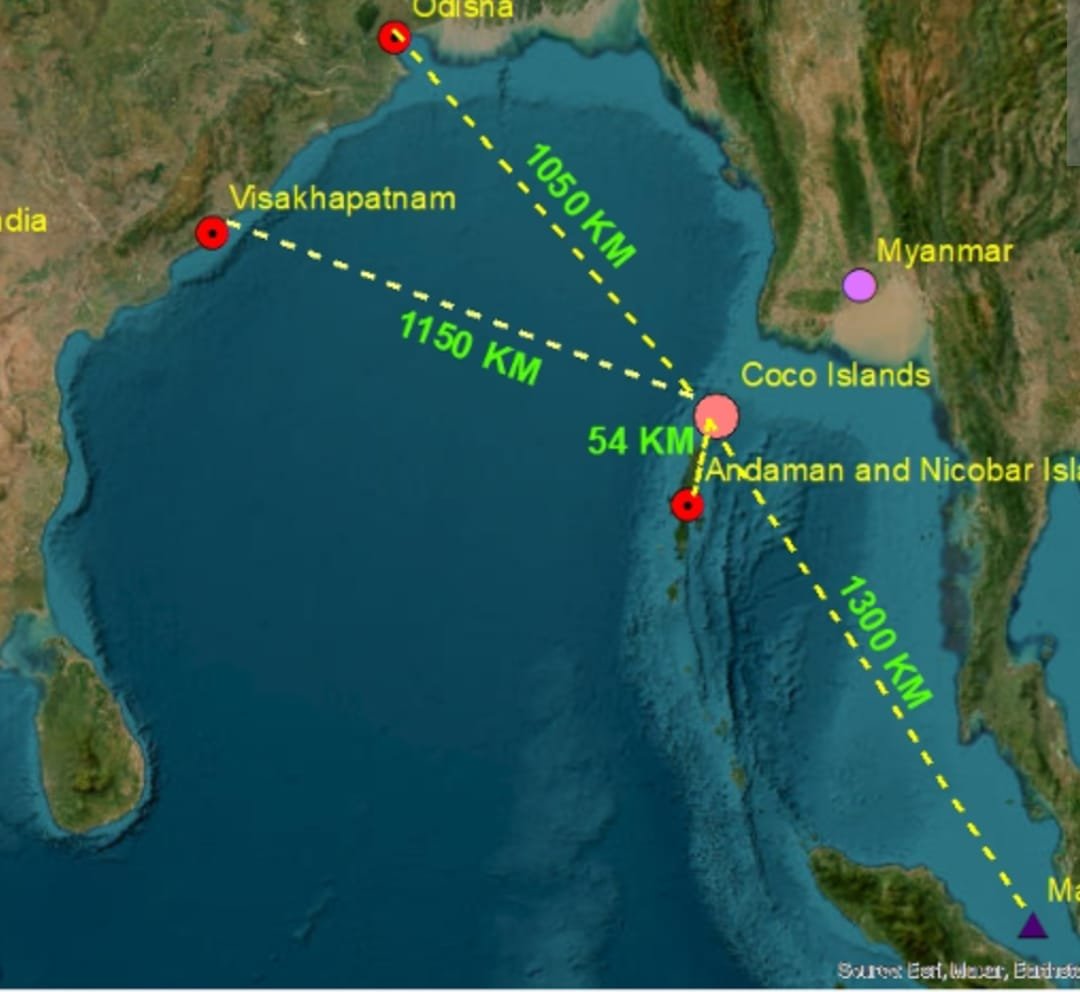Introduction
Cocos Island is a small chain of islands off the South Western Coast of mainland Myanmar. Recently, these Islands have been given away by Myanmar on a 30 years lease to China causing a political flash point in the Indo-Pacific region. This is being widely seen as a strategic move by China to reshape the balance of power in the Indian Ocean in the years to come.
Strategic Location of Cocos Island
This archipelago comprises of 17 small islands, which is broadly divided into two parts, Great Coco and Small Coco. The total area of the archipelago is about 21.5 Sq km. These Islands lie in the Bay of Bengal, barely 55km North of Indian Andaman islands.
To the East of Cocos Island lies the Andaman Sea and further beyond is the gateway to the South China Sea, the Strait Malacca.
Strategic Significance for China
China has recently started upgrading the infrastructure, especially for military use, on the islands, like runways, radar stations, as also, up scaling the Naval facilities. The major reason for China to do so is that it wants to provide trade security to its sea-lanes and strategic depth for force projection in the Indian Ocean region.
Nearly 80% of China’s global trade from the Middle East, Africa and Europe transit through the narrow Strait of Malacca before entering the South China Sea. Hence, this Strait becomes a strategic bottleneck, which is jointly managed by Singapore, Malaysia and Indonesia, countries that have been cautious of China’s expansionism in the South China Sea. Moreover, US and Indian military bases flank the Strait of Malacca on either side, putting China’s shipping lanes under close surveillance.
China fears a risk of the blockade of Strait of Malacca in case of hostilities to cut off its supply routes – experts call it ‘China’s Malacca Dilemma’.
The Cocos Islands are perfectly located to monitor and secure the movement of China’s supplies through the choke point of Strait of Malacca and gaining a foothold immediately North of it provides China with a sense of security and relief.
What is in it for Myanmar?
Myanmar is being ruled by a dictatorial regime of the military junta since 2021. Resultantly, it has faced global isolation and trade embargoes in terms of sanctions. However, China is one of the countries that has openly engaged with the military junta and supported the regime in infrastructure development projects and maintained trade relations with Myanmar. China is Myanmar’s largest trading partner with a bilateral trade of about $19 bilion.
Myanmar by leasing out the Cocos Islands to China has economically benefitted from this investment. Besides, Myanmar has won the goodwill of China to provide diplomatic recognition and a formal protection, especially because India and Myanmar have had a historical dispute over the sovereignty of the Little Cocos Island. India will have to deal with China and not Myanmar on this issue henceforth. Moreover, leasing the Cocos Island to China helps Myanmar to assert its control over the complete chain of Islands, including the Little Coco.
Hence, leasing out of Cocos Islands to China is a geo-political shield for the military junta in Myanmar.
Implications for India
Cocos Islands provide China with a strategic military base for force projection into the Eastern Indian Ocean, if required. This development is being seen as a counter to the influence, presently enjoyed by India and USA in this region.
An upgraded military base of China in Coco Island can be viewed as an ‘unsinkable aircraft carrier’ that will enable China to extend its military area of influence.
India has always considered the Indian Ocean as its own backyard. India has 7500 km coastline with several deep-water ports and has traditionally felt superior in comparison to its other smaller neighbours. Now, with China establishing a military base barely 55km from Andaman’s, the strategic balance of power has started to shift.
Further, this development may not be seen in isolation. China has already developed the Gwadhar Port, taken the Humbantota Port from Srilanka on a 99 years lease and established a logistic base in Djibouti off the East coast of Africa.
Most significant is the timing and context of this move by China. The recent OP SINDOOR has clearly shown China’s intent and the relationship with India is at an all time low. Both nations are jostling for influence in the region, especially to attract foreign investors for manufacturing in their respective country.
Implications for USA
China’s presence in the Indian Ocean region is being viewed by USA also as a threat to its interests and influence in the Indo-Pacific, which has been its strategic cornerstone for many years.
A military base of China in Cocos Island will dominate maritime choke points, limit freedom of movement and surveillance, as also threaten Changi Naval Base of USA in Singapore in case of a war. Once China upgrades the infrastructure at Coco Island it may be equated with the Diego Garcia US Base in the Indian Ocean. The same will eventually shift the balance of power in the India Ocean region.
Conclusion
China’s long-term strategy appears to establish a network of bases that can support long-range operations and protects sea lines. Projection of power also serves as a ‘threat in being’ for hostile nations, especially a superpower like USA to challenge China’s dominance in the region.
Lastly, this development highlights a larger global trend, which is that the traditional spheres of influence are being reconfigured to bring about changes in the regional power dynamics. Moreover, in the present age of globalization, trade corridors, ports and forward operating bases may be considered as new frontiers of power.
India must understand the urgency and need to mordernise its Naval assets prioritise economic growth through manufacturing under ‘Make in India’, deepen regional alliances and reconsider strategy to counter balance China’s growing influence.




